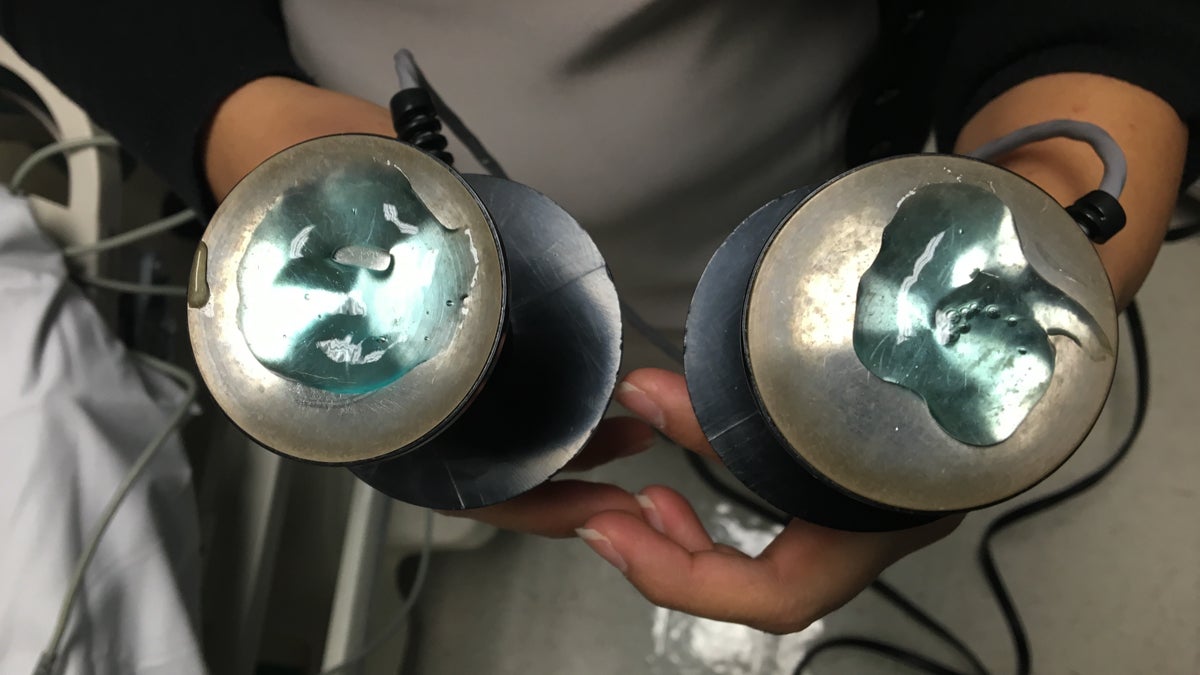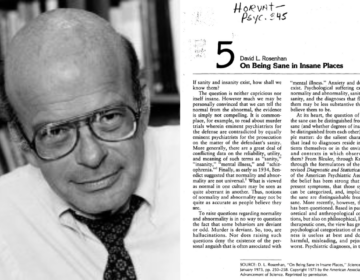How electroconvulsive therapy’s troubled past has colored its modern use
Listen 12:05
Dr. Priya Musunuri, a geriatric psychiatrist at Einstein Medical Center in Philadelphia, prepares to administer electroconvulsive therapy. (Elana Gordon/WHYY)
Elyse Hunt hit rock bottom last summer. She had pummeled deeply into an already serious depression, leaving her bedridden and contemplating suicide. And one point, the condition left her hospitalized.
“I was ready to go,” she recalled, from her Hampton, Virginia home.
Ten years had passed since a doctor diagnosed her with severe depression with psychosis. From the start, she engaged in therapy and then became a volunteer mental health educator. But by age 29, she relapsed. The medications, she says, had stopped working and she had developed a form of treatment-resistant depression.
Then came these words from her doctor: electroconvulsive therapy. Would she consider it?
Not a chance.
“I kinda shot my doctor down right away, and I was like, ‘Oh no, I’m not doing that!'”
Hunt’s reaction is common, even amid her dire situation. Electroconvulsive therapy, widely known as shock therapy, or ECT, has been an icon for medical abuse in the public mind. It’s one of the most polarizing treatments in medicine.
And yet, psychiatrists have long turned to ECT, a method of stimulating a seizure through an electric shock to the brain, as an important treatment for patients who, battling profound depression, mania or the risk of self harm, aren’t responding to other options.
Conflicting images
All over pop culture, ECT can conjure up some pretty grisly images. Just last year, the film the Suicide Squad showed some version of ECT being used as torture. Psychiatrists like Dr. Priya Musunuri at Einstein Hospital in Philadelphia, find the portrayals worrisome. They perpetuate inaccurate and outdated ideas about how ECT works, she says, and make it harder to be a proponent to patients in the face of misperceptions.
“There’s a lot of stigma,” she said. “People think it’s barbaric and painful and it shouldn’t be given. But it’s very comfortable for the patient.”
Google ECT and this disturbing scene pops up of a woman being strapped down and convulsing in pain on the BBC television drama White Heat.
Perhaps the most popular and enduring image is Jack Nicholson’s character in One Flew over the Cuckoo’s Nest.
This was the first image that flashed through Hunt’s mind, when her doctor brought up ECT.
“It was scary to me,” she said. “Because I still thought of it, that they didn’t put people to sleep for it or it was like a torture or something.”
Then Hunt saw this different video, made by a guy she trusted, whom she had connected with through her support community and it upended her understanding of the treatment.
“So I get wheeled into the treatment room. There is just this little box sitting next to me,” said Peter Cornish, in describing the video he posted a few years ago to YouTube of him getting ECT at a Salt Lake City Hospital in 2009.
There’s an anesthesiologist next to him and a psychiatrist, who will administer the actual shock.
“During the procedure, he’s asleep. There is no recollection for him,” said Ann Cornish, his wife.
In the video, she’s smiling and standing over Peter, who’s lying on the bed. Everything seems calm. The doctors put the nodes on this forehead, where the shocks will be administered.
Again, Cornish is out. He has also been given a paralytic medicine. He receives the shock and is relatively still. Then just his face and hand flinch as the seizure comes on.
“And literally, within a couple of minutes, Peter is then being wheeled out to a recovery area where within minutes he’s starting to wake up a little bit,” said Cornish.
“I honestly do say that for me going through an actual ECT shock treatment, it’s better than going to the dentist,” said Peter Cornish.
Really?
“I say that with absolute honesty.”
(It’s harder as the caregiver, says his wife.)
But even Peter Cornish admits he was wary when he first heard of ECT.
“I can distinctly remember the session with the psychiatrist where he brought it up, and I said ‘no way, I’m not getting my brain shocked! I’m ill but that’s not going to work,'” he recalled.
Cornish spiraled even deeper into his depression. Ten years went by before he finally considered it.
To many psychiatrists, ECT is an essential treatment for severe depression, a no-brainer. And yet to patients like Cornish and Hunt, ECT couldn’t be more scary and stigmatized.
So why the disconnect?
A troubled past
Jonathan Sadowsky, a medical historian at Case Western Reserve University in Cleveland, has spent the last 15 years looking for answers.
“I found these incredibly bifurcated images of, on the one hand, something close to a war crime, on the other hand, a safe human effective treatment,” Sadowsky said.
Sadowsky, who’s written a book about ECT, says this split dates back to the origins of the therapy itself.
In the early 1900s, he explains, psychiatrists thought that seizures could help treat schizophrenia. It was based on the belief that the brains of people with schizophrenia appeared to be the exact opposite of those with epilepsy.
“And the thinking was if we could induce symptoms of epilepsy, such as seizures, perhaps we could treat schizophrenia,” he said. This was at first done with chemicals, called chemical convulsive therapy,” he said.
Patients loathed it.
“It inspired a lot of fear. There was evidently a moment of terror after taking the medicine and before the seizure came on that patients hated,” Sadowsky said. “One Cleveland psychiatrist I met with who remembered back then said ‘we had to chase the patients around the room, the doctors, to get them to take their metrozol,’ the main substance used to induce the convulsions.”
Moving into the 1930s, two Italian doctors hit the scene.
“Ugo Cerletti and Lucio Bini were actually trying to develop a treatment that would be safer and more humane and less frightening to patients,” Sadowsky said.
Binni, the story goes, was at a slaughterhouse one day and “noticed they used electric shocks to stun pigs, before slaughtering them, and he noticed sometimes the shocks induced convulsions.”
They tried it on humans and…voila! ECT was born and exploded in the field of psychiatry.
It had clear therapeutic benefits, but the treatment was often used inappropriately and abusively, without consent or general anesthesia. It was used to “treat” gay people.
“Patients were traumatized by this,” Sadowsky said.
It was also used to control and even punish patients.
“There’s also evidence of people using it, ward attendants and people in other clinical situations, to discipline patients on hospital wards,” Sadowsky said. “In this sense, the images of ‘One Flew Over The Cuckoo’s Nest’ are not entirely inaccurate for the time that they were portrayed,” said Sadowsky, noting that the film came out two decades after the book was written.
This controversial past made ECT part of a bigger anti-psychiatry movement. Even as medicine has advanced, the negative reputation has remained ingrained in the social psyche today.
Advances in brain science
That’s really frustrating for psychiatrists like Stephen Seiner, who directs McLean Hospital’s Psychiatric Neurotherapeutics Program.
“So many things have changed, not just ECT but psychiatry in general,” Dr. Seiner said.
Modern ECT is mainly used for severe depression. Patients must agree to it first. They always get an anesthetic and a muscle relaxant. Seiner has been performing ECT for two decades at McLean hospital near Boston, which does some 10,000 treatments a year.
“It’s indispensable, and when you really need it, it’s going to be the most useful thing you have,” he said.
He describes ECT as the hammer in the depression tool kit. It’s kind of blunt, but more than that, it’s an essential option.
“But not everything is a nail, and I think we have to be careful about how we use ECT,” he said. “And that has evolved over the years.”
Today’s ECT is more directed and individualized. Doctors may administer different levels of electric current, directed at different parts of the brain. Patient’s go through a series of treatments, and the number and frequency depends on a lot of factors, like the patient’s initial condition and how they respond. Seiner says ECT is most effective for patients who need it the most, like those with the most severe, treatment-resistant depression.
“What ECT is basically doing is resetting the brain. It’s going to bring you back to your baseline,” he said. “So we say, if you were a happy go lucky person before depressed, that’s what aiming for. If you were a glass is half empty person, then that’s what aiming for. If you’re a Yankee’s fan, you’re still going to be a Yankee’s fan. We don’t have a strong enough treatment for that.”
Trade-offs
But ECT does come with trade-offs, even today.
“There are very few other treatments that both save lives – and I’ve had patients who’ve been transformed by getting ECT – and have left people feeling that the side effects are much greater than anticipated,” said Dr. Ken Duckworth, medical director for the National Alliance on Mental Illness.
ECT is definitely not for everyone.
“I tend to think of it as an equivalent of a chemotherapy,” Dr. Duckworth, who doesn’t himself administer ECT, said. “Which is that most people should have nothing to do with chemotherapy in their lives.”
But for those with serious depression or psychosis and understand the risks, it can be lifesaving.
Duckworth says within the patient advocacy community, some say they weren’t fully informed of the possible trade-offs. One concern is how lasting the benefits are. Many people return for follow up ECT treatments. But the main critique is memory loss.
“Memory is of course central to people’s identity,” he said.
Still, Historian Jonathan Sadowsky points out that many of the people who complain about the memory loss still stand by the treatment. One of the most recognizable examples is the actress and writer, Carrie Fisher, who died in December.
“Fisher went back for voluntary ECT, and she believed it helped her, but she also said ‘ECT is hungry, hungry for memory,'” Sadowsky said. “So this was not an embittered patient, somebody who felt the treatment was forced on them, this was someone who believed it helped her.”
Peter Cornish, the guy who made a video of his own treatment, says he feels like he’s in a fog after ECT.
“For me, what I feel happens is after about three or four treatments in a series, I get to the point where my brain gets fatigued,” he said. “To put in more layman’s terms, I sorta go into zombie mode. It’s not painful for me. It doesn’t hurt me, but I’m just very not engaged in life.”
Ann Cornish, his wife, says this can be very disconcerting for caregivers.
“It’s like a person’s there, but they’re not very responsive,” she said.
The memory loss from ECT typically falls into one of two categories, says Dr. Seiner at McLean Hospital. The first is the ability to lay down and store new memories.
“The good news is that effect tends to fade or go to normal within a month of ECT,” he said.
ECT can also affect retrograde memory, or the memories a person had before the treatment.
“Most commonly, that’s in the few months prior to ECT, and it tends to be more things you did once and didn’t think about it again,” Seiner said. “People won’t forget who their daughter is, but they might forget a piano recital of their daughter’s they went to three months ago.”
Seiner says it’s hard to test and track the depths of this, but doctors and researchers are figuring out ways to minimize the impact. That includes the type, level and way electric impulses are administered.
“You know the holy grail of ECT is finding a way to do it without any cognitive side effect, and I think we’re getting closer and closer to that,” he said. “But there’s still no free lunch.”
An ‘exciting’ future
Even Seiner admits he doesn’t fully understand how ECT works. Like the inner workings of depression and the mind itself, ECT is surrounded by mystery.
Dr. Sarah Lisanby, a longtime researcher in the field and director of translational research at the National Institute of Mental Health, says the science is catching up.
“As much as today’s ECT is dramatically different than ECT used to be in the 30s and 40s when it first came out, likewise ECT of future I think is going to look a lot different than the way we do it today,” said Lisanby. “I think that’s inspiring and exciting.”
Understanding ECT, she says, is a high scientific priority.
“If you could break down the ingredient, how you’re able to rapidly interrupt the impulses to commit suicide, if you could answer those questions, it could help us as a field to develop more targeted and safer treatments for patients,” Lisanby said.
Lisanby says advances in brain imaging are leading to new understandings of ECT, like the way it affects certain parts of the brain and stimulates neurons, or brain cells. Alternative treatments are out there, including transcranial magnetic stimulation, and others are in the works, including magnetic seizure therapy.
But as complicated as the brain is, Lisanby also says electricity is central to its very existence, and something not to be feared.
“The amazing thing is, we’ve got electrical currents in our brain right now, as we’re talking to each other, as you’re listening to me, that’s how the brain works,” Lisanby said. “Neuronal activity, the way that we think, the way that we move, the way that we ponder the world and understand ourselves, all of this brain activity is electrical activity. When brain cells or neurons fire, there are little tiny electrical impulses going through parts of the brain. And that’s normal, that’s biology, that’s how our brains are wired.”
And it’s not just the brain. Electricity pulses through the heart. It’s used to keep it in rhythm and pumping. Lisanby worries too many people carry an inaccurate view of ECT, and that it has created a huge gap between those who could really benefit from it and those who actually get it.
“There’s a mismatch. There’s many more people with treatment-resistant depression than people who are receiving ECT,” she said. “I think we should be more afraid of depression and how serious it can be when it’s not effectively treated.”
Countering Stigma
Elyse Hunt could have been one of them.
“I can honestly say that ECT has saved my life,” Hunt said.
Hunt is still getting treatments, and it’s not a silver bullet. She’s on medication, too. Her journey with depression isn’t over. But she’s starting to recognize her old self again. She’s really glad she did her ECT research.
“I still had all these preconceived notions about it that weren’t true,” she said.
For Peter Cornish, nothing annoys him more than finding inaccurate images of ECT perpetuated on TV and online. That’s part of why he posted the video of him getting ECT in the first place.
He also openly talks about depression and treatment, kind of in the way someone might tell a friend what they had for dinner the other night. He remembers this one time, he showed up at his regular coffee shop after being away for several months getting treatment.
“I had my older son, Ian, in the car with me, and someone said, ‘Peter! We haven’t seen you, what’s going on?'”
He went with the truth, responding that he had been depressed and just gone through a series of successful shock treatments.
“And that person, who was not someone I knew very well, said, ‘Hey, that’s really interesting. I know someone who’s been through it, and it’s really cool to be able to talk about it.'”
Moments later, as he drove off with his teenage son, a wave of fear overtook him. He worried he had just embarrassed him.
“And he turned to me, and he said, ‘Dad, it is so cool that you can talk to people like that.'”
WHYY is your source for fact-based, in-depth journalism and information. As a nonprofit organization, we rely on financial support from readers like you. Please give today.






